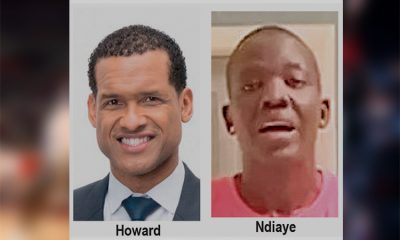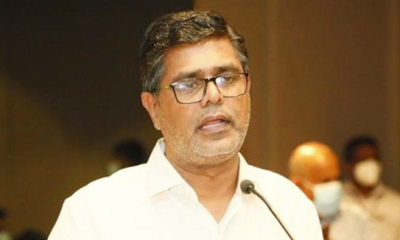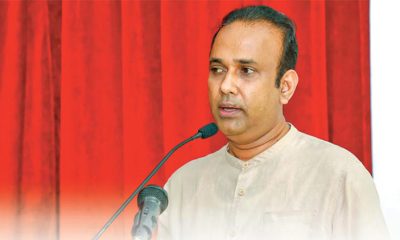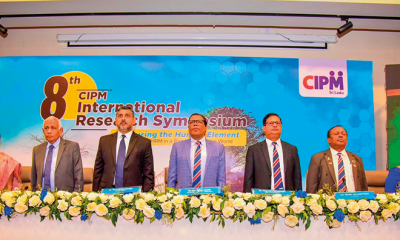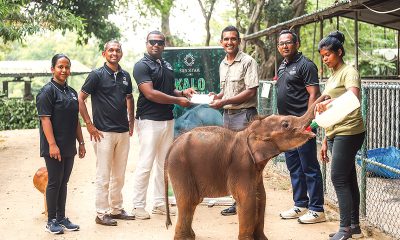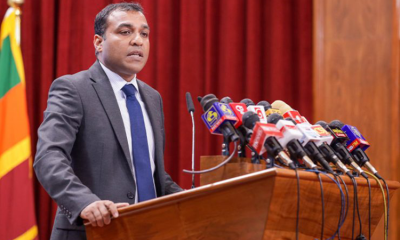Features
Flood protection of Colombo Metropolitan Region-An alternative scheme

By Dr Janaka Ratnasiri
I thank Eng. Anton Nanayakkara (AN)’s write-up in The Island of 28.07.2020, responding to my article on Flood Protection of Colombo Metropolitan Region which appeared in The Island of 21.07.2020. The main purpose of my article was to highlight the fact that the government after getting Japanese Consultants to formulate a Master Plan for flood protection of Colombo Metro Region at great cost, what is being implemented as a priority project is only a clean-up of the Weras Ganga basin, making a mockery of the word Master Plan. This area is totally outside the Greater Colombo area with no impact on its flooding. AN has failed to comment on this issue.
METRO COLOMBO URBAN DEVELOPMENT
PROJECT
With the failure of the Master Plan to address the flood situation within the city and its suburbs, Sri Lanka Land Development Corporation (SLLDC) has taken the initiative to develop a separate project titled Metro Colombo Urban Development Project (MCUDP) to address this issue. This project expected to be executed during 2012 – 2020 is estimated to cost USD 104 Million (SLLDC Website). It will address flood mitigation in areas covered by the Colombo Municipal Council, Sri Jayewardenapura, Battaramulla, Rajagiriya, Madiwela and Dehiwala. Activities described under “Improvements to existing drainage systems” in my previous article of July 21st were in fact carried out by SLLDC under this project.
COMMENTS ON ENG. NANAYAKKARA’S
RESPONSES
In his response, AN has made certain remarks on some statements appearing in my article and questions their validity. What I have said are totally based on material extracted from other sources including the JICA reports and the website of the SLLDC and not my own suggestions. It appears that AN seems to be unaware of the latest situation in this regard, and hence they need clarification. My comments are given against each of AN’s statements which are given below using material extracted from SLLDC website – Special Projects pages.
1. “The Madiwela East Diversion (MED), remaining dry most of the time, as mentioned, may be due to its wrong location, too far upstream of the Kelani Ganga about 10 miles above the historic Nagalagam Street outfall”.
COMMENT: MED was established by constructing a new canal from the Thalangama Tank up to the origin of the existing natural canal flowing through Malabe paddy fields parallel to Chandrika Kumarathunga Mawatha. It has its natural outfall at Ambatale. The topography of the area does not permit shifting of this outfall further downstream.
2. “Even during floods of the Kelani Ganga, this outfall No 1 (See plan) has to be closed, long before Nagalagam Street outfall closing at +5.00 ft MSL, the accepted minor flood level for Colombo, negating the very purpose for which this canal was built”.
COMMENT: The SLLDC is currently building a pumping station at Ambatale across the MED canal to pump water to the river when its water level rises during heavy rainfall, at a cost of USD 5.85 Million and LKR 1,181 Million (SLLRDC website).
3. “The learned doctor has not noticed the extent to which the Thalangama Tank had silted up, reducing the capacity to retain flood water (about 50 ac.ft) entering the Parliament lake”.
COMMENT: In a project carried out by the SLLDC during 2016 – 2018, the tank was dredged to increase its water holding capacity and remove unnecessary growth on the tank bund, at a cost of LKR 107 million. In any case, I wonder how even a professional hydrologist could notice the extent of silting of the tank just by looking at it.
4. “This gate was constructed at ID’s flood control premises to pump water from the Kelani Ganga to the Beira Lake, for the purpose of cleaning the lake. The project ceased soon after the flood. Strangely, no inquiry was made. It was all swept under the carpet”.
COMMENT: According the SLLDC website, it has built three gates across Kolonnawa Canal, Heen Ela and St. Sebastian canal at the crossing of New Kelani Bridge Road to isolate the canal system enabling water to be pumped back into the canal system from the river by operating the pumps installed at St. Sebastian outfall in the reverse direction. This work to be carried out during 2018 – 2020 is estimated to cost of USD 5.85 million and LKR 1181 million. So, it is not a case of sweeping under the carpet.
5. “Dr. R’s reference to the Beira Lake, too, needs some clarifications. The Beira Lake is not a natural lake. It is an artificial lake also kept at an artificial level, of 6.00 ft above mean sea level, by the Beira Spillway”.
COMMENT: A pumping station is being built across St. Sebastian Canal at Maradana for pumping water from the canal to Beira Lake during periods of high rainfall in Colombo. This work to be carried out during 2019 -2020 is estimated to cost of USD 5.93 million and LKR 165 million. (See also the last paragraph).
6. “Ignoring many other references, contained in Dr R’s article, let me now say a few words about narrowing of bridges, mentioned in it. This is not a matter of life and death, as made out to be. Any hydrologist will agree that within the narrowed section, the velocity will increase to make up for the constriction”.
COMMENT: Widening of the canals and removing bottleneck were not proposals that I made, but what are actually executed by SLLDC as described in its website. Kolonnawa Canal Diversion Stage III says “the canal has become very narrow at certain sections due to encroachment. Some resettlement and land acquisitions are undertaken to remove bottlenecks”. This work to be carried out during 2018-2020 will cost of LKR 1,000 million. Diversion Stage IV also refers to removing two bottlenecks near the outfall.
7. “If, as proposed, the southern diversion takes place, such a canal would become a “trans-basin diversion” let alone the new outfall getting pushed about 20 miles, down south, to Panadura; not to mention reversing the natural flow direction, within the Madiwela catchment, and aggravating the already existing problems, within Bolgoda”.
COMMENT: The proposed diversion is not the first trans-basin diversion in Sri Lanka. Under the Mahaweli Scheme, there are trans-basin diversions. There are even such diversions among ancient works including diversion of Kala Oya to Malwathu Oya basin and Amban Ganga to Yan Oys basin. More recently, Kalu Ganga (Matale) was diverted to Amban Ganga basin under Moragahakanda Project, Uma Oya is being diverted to Kirindi Oya basin. It is also proposed to divert Gin Ganga to Nilwala basin. If Madiwela South diversion is the only practical option available to protect Sri Jayewardenapura area from flooding, it should be pursued after addressing whatever environmental issues that it may cause.
8. “The proposals (which) I have been making for more than 30 years, do not go against nature, no damage to environment by digging new canals, no underground tunnels of large diameter, no widening of bridges, and no pumping”.
COMMENT: If AN’s proposal with no digging of new canals, no tunneling or no widening of canals had merit, why wasn’t it accepted by authorities for implementation all these 30 years?
OPTION WITH NO DIGGING, TUNNELING AND PUMPING
As mentioned in my previous article, the Diyawannawa Lake has two draining outlets, one via Kolonnawa Canal and the other via Wellawatta Canal. The Kolonnawa Canal branches into three canals with outfalls to the Kelani River at Grandpass, Kotuwila and Ambatale which need pumping during heavy rainfall days. Hence, only the Wellawatta Canal is available for draining direct into the sea without resorting to digging new canals, or building tunnels or installing pumping stations. Under the MCUDP project, the stretch of Wellawatta Canal beyond the Galle Road was dredged, widened and the outfall improved at a cost of LKR 111.6 Million. It is to be seen whether this outlet together with the improved outfalls to Kelani River could handle the draining of Diyawannawa Lake during an extreme rainfall event.
ALTERNATIVE PROPOSAL TO DRAIN FLOOD WATER
AN has expressed his reservations about using the Beira Lake as an outfall for flood water as the level of the spillway cannot be adjusted. Though a sum of LKR 1,350 million is spent on building a pumping station at Maradana to divert flood water coming along the Dematagoda Canal into the Beira Lake and then to the sea, there is a doubt as to whether this diversion will work. If it works, it will take flood water from Kotte diverted to St. Sebastian Canal first to the Floating Market and then to the Beira Lake before the water enters the spillway near Galle Face. This will invariably raise the water level of Beira Lake which is presently maintained at 1.8 m above mean sea level to prevent buildings constructed on wooden piles along the lake from collapsing. However, according to an environment screening study on a project for rehabilitation of the Beira Lake carried out by Moratuwa University in 2011, any changes to the water level of the Beira lake can have an adverse effect on the stability of these foundations.
There is however, another alternative option available to improve the draining of Kotte flood water flowing along Dematagoda Canal into the river without posing any of these problems. That is by diverting water flowing in Dematagoda Canal direct into Kiththamphuwa Ela (KE) before it joins with St. Sebastian Canal, by constructing a new canal branching off from the Dematagoda Canal just before it crosses the railway line. This canal could run parallel to the railway line and join with the KE where it makes a U-turn near Welewatta Road. This link canal is only about 0.5 km long and this area comes mostly under railway reservation. The stretch of KE which runs parallel to the railway line up to the river outfall is being widened and dredged under the Kolonnawa Canal Diversion Stage IV at a cost of LKR 1,432 Million. Hence, construction of this new link canal could be undertaken as a part of this project.
The distance to the existing river outfall along St. Sebastian Canal from this branching point is 3.0 km while the distance to the Beira Lake outfall via St. Sebastian Canal in the opposite direction 5.2 km, whereas the distance to the river outfall along the proposed link canal and KE is only 1.7 km. Further, the present St. Sebastian Canal route has six road crossings and several bends while the route via Beira Lake has eight road crossings. Also, the stretch of St. Sebastian Canal behind the Technical College passes through a narrow passage cut through a hill with no room for widening. On the other hand, the proposed route via the link canal and KE is short and straight with only one road crossing at Orugodawatta and is a better option to drain the Kotte flood water into Kelani River, than the proposed scheme via Beira Lake.
CONCLUSION
The SLLDC has already executed several projects worth LKR 1,165 Million with World Bank funding to improve the drainage in several canals in the city and its suburbs. Several more projects estimated to cost over LKR 4,500 Million and USD 44 Million are on-going. This includes a project to take flood water from Kotte all the way to Beira Lake and then to spillway at Galle Face for discharging into the sea by reversing the flow in St. Sebastian Canal. However, this does not appear sensible even to a layman like myself. It is more sensible to drop this proposal and instead develop the link canal to take flood water flowing in Dematagoda Canal direct to KE stretch running parallel to the railway line and thereafter to the Kelani river. The pumping equipment intended for diverting flood water via Beira Lake could be installed at the outfall of KE near Kalu Palama, enabling it to remove the flood water during heavy rainfall.
Features
The heart-friendly health minister

by Dr Gotabhya Ranasinghe
Senior Consultant Cardiologist
National Hospital Sri Lanka
When we sought a meeting with Hon Dr. Ramesh Pathirana, Minister of Health, he graciously cleared his busy schedule to accommodate us. Renowned for his attentive listening and deep understanding, Minister Pathirana is dedicated to advancing the health sector. His openness and transparency exemplify the qualities of an exemplary politician and minister.
Dr. Palitha Mahipala, the current Health Secretary, demonstrates both commendable enthusiasm and unwavering support. This combination of attributes makes him a highly compatible colleague for the esteemed Minister of Health.
Our discussion centered on a project that has been in the works for the past 30 years, one that no other minister had managed to advance.
Minister Pathirana, however, recognized the project’s significance and its potential to revolutionize care for heart patients.
The project involves the construction of a state-of-the-art facility at the premises of the National Hospital Colombo. The project’s location within the premises of the National Hospital underscores its importance and relevance to the healthcare infrastructure of the nation.
This facility will include a cardiology building and a tertiary care center, equipped with the latest technology to handle and treat all types of heart-related conditions and surgeries.
Securing funding was a major milestone for this initiative. Minister Pathirana successfully obtained approval for a $40 billion loan from the Asian Development Bank. With the funding in place, the foundation stone is scheduled to be laid in September this year, and construction will begin in January 2025.
This project guarantees a consistent and uninterrupted supply of stents and related medications for heart patients. As a result, patients will have timely access to essential medical supplies during their treatment and recovery. By securing these critical resources, the project aims to enhance patient outcomes, minimize treatment delays, and maintain the highest standards of cardiac care.
Upon its fruition, this monumental building will serve as a beacon of hope and healing, symbolizing the unwavering dedication to improving patient outcomes and fostering a healthier society.We anticipate a future marked by significant progress and positive outcomes in Sri Lanka’s cardiovascular treatment landscape within the foreseeable timeframe.
Features
A LOVING TRIBUTE TO JESUIT FR. ALOYSIUS PIERIS ON HIS 90th BIRTHDAY

by Fr. Emmanuel Fernando, OMI
Jesuit Fr. Aloysius Pieris (affectionately called Fr. Aloy) celebrated his 90th birthday on April 9, 2024 and I, as the editor of our Oblate Journal, THE MISSIONARY OBLATE had gone to press by that time. Immediately I decided to publish an article, appreciating the untiring selfless services he continues to offer for inter-Faith dialogue, the renewal of the Catholic Church, his concern for the poor and the suffering Sri Lankan masses and to me, the present writer.
It was in 1988, when I was appointed Director of the Oblate Scholastics at Ampitiya by the then Oblate Provincial Fr. Anselm Silva, that I came to know Fr. Aloy more closely. Knowing well his expertise in matters spiritual, theological, Indological and pastoral, and with the collaborative spirit of my companion-formators, our Oblate Scholastics were sent to Tulana, the Research and Encounter Centre, Kelaniya, of which he is the Founder-Director, for ‘exposure-programmes’ on matters spiritual, biblical, theological and pastoral. Some of these dimensions according to my view and that of my companion-formators, were not available at the National Seminary, Ampitiya.
Ever since that time, our Oblate formators/ accompaniers at the Oblate Scholasticate, Ampitiya , have continued to send our Oblate Scholastics to Tulana Centre for deepening their insights and convictions regarding matters needed to serve the people in today’s context. Fr. Aloy also had tried very enthusiastically with the Oblate team headed by Frs. Oswald Firth and Clement Waidyasekara to begin a Theologate, directed by the Religious Congregations in Sri Lanka, for the contextual formation/ accompaniment of their members. It should very well be a desired goal of the Leaders / Provincials of the Religious Congregations.
Besides being a formator/accompanier at the Oblate Scholasticate, I was entrusted also with the task of editing and publishing our Oblate journal, ‘The Missionary Oblate’. To maintain the quality of the journal I continue to depend on Fr. Aloy for his thought-provoking and stimulating articles on Biblical Spirituality, Biblical Theology and Ecclesiology. I am very grateful to him for his generous assistance. Of late, his writings on renewal of the Church, initiated by Pope St. John XX111 and continued by Pope Francis through the Synodal path, published in our Oblate journal, enable our readers to focus their attention also on the needed renewal in the Catholic Church in Sri Lanka. Fr. Aloy appreciated very much the Synodal path adopted by the Jesuit Pope Francis for the renewal of the Church, rooted very much on prayerful discernment. In my Religious and presbyteral life, Fr.Aloy continues to be my spiritual animator / guide and ongoing formator / acccompanier.
Fr. Aloysius Pieris, BA Hons (Lond), LPh (SHC, India), STL (PFT, Naples), PhD (SLU/VC), ThD (Tilburg), D.Ltt (KU), has been one of the eminent Asian theologians well recognized internationally and one who has lectured and held visiting chairs in many universities both in the West and in the East. Many members of Religious Congregations from Asian countries have benefited from his lectures and guidance in the East Asian Pastoral Institute (EAPI) in Manila, Philippines. He had been a Theologian consulted by the Federation of Asian Bishops’ Conferences for many years. During his professorship at the Gregorian University in Rome, he was called to be a member of a special group of advisers on other religions consulted by Pope Paul VI.
Fr. Aloy is the author of more than 30 books and well over 500 Research Papers. Some of his books and articles have been translated and published in several countries. Among those books, one can find the following: 1) The Genesis of an Asian Theology of Liberation (An Autobiographical Excursus on the Art of Theologising in Asia, 2) An Asian Theology of Liberation, 3) Providential Timeliness of Vatican 11 (a long-overdue halt to a scandalous millennium, 4) Give Vatican 11 a chance, 5) Leadership in the Church, 6) Relishing our faith in working for justice (Themes for study and discussion), 7) A Message meant mainly, not exclusively for Jesuits (Background information necessary for helping Francis renew the Church), 8) Lent in Lanka (Reflections and Resolutions, 9) Love meets wisdom (A Christian Experience of Buddhism, 10) Fire and Water 11) God’s Reign for God’s poor, 12) Our Unhiddden Agenda (How we Jesuits work, pray and form our men). He is also the Editor of two journals, Vagdevi, Journal of Religious Reflection and Dialogue, New Series.
Fr. Aloy has a BA in Pali and Sanskrit from the University of London and a Ph.D in Buddhist Philosophy from the University of Sri Lankan, Vidyodaya Campus. On Nov. 23, 2019, he was awarded the prestigious honorary Doctorate of Literature (D.Litt) by the Chancellor of the University of Kelaniya, the Most Venerable Welamitiyawe Dharmakirthi Sri Kusala Dhamma Thera.
Fr. Aloy continues to be a promoter of Gospel values and virtues. Justice as a constitutive dimension of love and social concern for the downtrodden masses are very much noted in his life and work. He had very much appreciated the commitment of the late Fr. Joseph (Joe) Fernando, the National Director of the Social and Economic Centre (SEDEC) for the poor.
In Sri Lanka, a few religious Congregations – the Good Shepherd Sisters, the Christian Brothers, the Marist Brothers and the Oblates – have invited him to animate their members especially during their Provincial Congresses, Chapters and International Conferences. The mainline Christian Churches also have sought his advice and followed his seminars. I, for one, regret very much, that the Sri Lankan authorities of the Catholic Church –today’s Hierarchy—- have not sought Fr.
Aloy’s expertise for the renewal of the Catholic Church in Sri Lanka and thus have not benefited from the immense store of wisdom and insight that he can offer to our local Church while the Sri Lankan bishops who governed the Catholic church in the immediate aftermath of the Second Vatican Council (Edmund Fernando OMI, Anthony de Saram, Leo Nanayakkara OSB, Frank Marcus Fernando, Paul Perera,) visited him and consulted him on many matters. Among the Tamil Bishops, Bishop Rayappu Joseph was keeping close contact with him and Bishop J. Deogupillai hosted him and his team visiting him after the horrible Black July massacre of Tamils.
Features
A fairy tale, success or debacle

Sri Lanka-Singapore Free Trade Agreement
By Gomi Senadhira
senadhiragomi@gmail.com
“You might tell fairy tales, but the progress of a country cannot be achieved through such narratives. A country cannot be developed by making false promises. The country moved backward because of the electoral promises made by political parties throughout time. We have witnessed that the ultimate result of this is the country becoming bankrupt. Unfortunately, many segments of the population have not come to realize this yet.” – President Ranil Wickremesinghe, 2024 Budget speech
Any Sri Lankan would agree with the above words of President Wickremesinghe on the false promises our politicians and officials make and the fairy tales they narrate which bankrupted this country. So, to understand this, let’s look at one such fairy tale with lots of false promises; Ranil Wickremesinghe’s greatest achievement in the area of international trade and investment promotion during the Yahapalana period, Sri Lanka-Singapore Free Trade Agreement (SLSFTA).
It is appropriate and timely to do it now as Finance Minister Wickremesinghe has just presented to parliament a bill on the National Policy on Economic Transformation which includes the establishment of an Office for International Trade and the Sri Lanka Institute of Economics and International Trade.
Was SLSFTA a “Cleverly negotiated Free Trade Agreement” as stated by the (former) Minister of Development Strategies and International Trade Malik Samarawickrama during the Parliamentary Debate on the SLSFTA in July 2018, or a colossal blunder covered up with lies, false promises, and fairy tales? After SLSFTA was signed there were a number of fairy tales published on this agreement by the Ministry of Development Strategies and International, Institute of Policy Studies, and others.
However, for this article, I would like to limit my comments to the speech by Minister Samarawickrama during the Parliamentary Debate, and the two most important areas in the agreement which were covered up with lies, fairy tales, and false promises, namely: revenue loss for Sri Lanka and Investment from Singapore. On the other important area, “Waste products dumping” I do not want to comment here as I have written extensively on the issue.
1. The revenue loss
During the Parliamentary Debate in July 2018, Minister Samarawickrama stated “…. let me reiterate that this FTA with Singapore has been very cleverly negotiated by us…. The liberalisation programme under this FTA has been carefully designed to have the least impact on domestic industry and revenue collection. We have included all revenue sensitive items in the negative list of items which will not be subject to removal of tariff. Therefore, 97.8% revenue from Customs duty is protected. Our tariff liberalisation will take place over a period of 12-15 years! In fact, the revenue earned through tariffs on goods imported from Singapore last year was Rs. 35 billion.
The revenue loss for over the next 15 years due to the FTA is only Rs. 733 million– which when annualised, on average, is just Rs. 51 million. That is just 0.14% per year! So anyone who claims the Singapore FTA causes revenue loss to the Government cannot do basic arithmetic! Mr. Speaker, in conclusion, I call on my fellow members of this House – don’t mislead the public with baseless criticism that is not grounded in facts. Don’t look at petty politics and use these issues for your own political survival.”
I was surprised to read the minister’s speech because an article published in January 2018 in “The Straits Times“, based on information released by the Singaporean Negotiators stated, “…. With the FTA, tariff savings for Singapore exports are estimated to hit $10 million annually“.
As the annual tariff savings (that is the revenue loss for Sri Lanka) calculated by the Singaporean Negotiators, Singaporean $ 10 million (Sri Lankan rupees 1,200 million in 2018) was way above the rupees’ 733 million revenue loss for 15 years estimated by the Sri Lankan negotiators, it was clear to any observer that one of the parties to the agreement had not done the basic arithmetic!
Six years later, according to a report published by “The Morning” newspaper, speaking at the Committee on Public Finance (COPF) on 7th May 2024, Mr Samarawickrama’s chief trade negotiator K.J. Weerasinghehad had admitted “…. that forecasted revenue loss for the Government of Sri Lanka through the Singapore FTA is Rs. 450 million in 2023 and Rs. 1.3 billion in 2024.”
If these numbers are correct, as tariff liberalisation under the SLSFTA has just started, we will pass Rs 2 billion very soon. Then, the question is how Sri Lanka’s trade negotiators made such a colossal blunder. Didn’t they do their basic arithmetic? If they didn’t know how to do basic arithmetic they should have at least done their basic readings. For example, the headline of the article published in The Straits Times in January 2018 was “Singapore, Sri Lanka sign FTA, annual savings of $10m expected”.
Anyway, as Sri Lanka’s chief negotiator reiterated at the COPF meeting that “…. since 99% of the tariffs in Singapore have zero rates of duty, Sri Lanka has agreed on 80% tariff liberalisation over a period of 15 years while expecting Singapore investments to address the imbalance in trade,” let’s turn towards investment.
Investment from Singapore
In July 2018, speaking during the Parliamentary Debate on the FTA this is what Minister Malik Samarawickrama stated on investment from Singapore, “Already, thanks to this FTA, in just the past two-and-a-half months since the agreement came into effect we have received a proposal from Singapore for investment amounting to $ 14.8 billion in an oil refinery for export of petroleum products. In addition, we have proposals for a steel manufacturing plant for exports ($ 1 billion investment), flour milling plant ($ 50 million), sugar refinery ($ 200 million). This adds up to more than $ 16.05 billion in the pipeline on these projects alone.
And all of these projects will create thousands of more jobs for our people. In principle approval has already been granted by the BOI and the investors are awaiting the release of land the environmental approvals to commence the project.
I request the Opposition and those with vested interests to change their narrow-minded thinking and join us to develop our country. We must always look at what is best for the whole community, not just the few who may oppose. We owe it to our people to courageously take decisions that will change their lives for the better.”
According to the media report I quoted earlier, speaking at the Committee on Public Finance (COPF) Chief Negotiator Weerasinghe has admitted that Sri Lanka was not happy with overall Singapore investments that have come in the past few years in return for the trade liberalisation under the Singapore-Sri Lanka Free Trade Agreement. He has added that between 2021 and 2023 the total investment from Singapore had been around $162 million!
What happened to those projects worth $16 billion negotiated, thanks to the SLSFTA, in just the two-and-a-half months after the agreement came into effect and approved by the BOI? I do not know about the steel manufacturing plant for exports ($ 1 billion investment), flour milling plant ($ 50 million) and sugar refinery ($ 200 million).
However, story of the multibillion-dollar investment in the Petroleum Refinery unfolded in a manner that would qualify it as the best fairy tale with false promises presented by our politicians and the officials, prior to 2019 elections.
Though many Sri Lankans got to know, through the media which repeatedly highlighted a plethora of issues surrounding the project and the questionable credentials of the Singaporean investor, the construction work on the Mirrijiwela Oil Refinery along with the cement factory began on the24th of March 2019 with a bang and Minister Ranil Wickremesinghe and his ministers along with the foreign and local dignitaries laid the foundation stones.
That was few months before the 2019 Presidential elections. Inaugurating the construction work Prime Minister Ranil Wickremesinghe said the projects will create thousands of job opportunities in the area and surrounding districts.
The oil refinery, which was to be built over 200 acres of land, with the capacity to refine 200,000 barrels of crude oil per day, was to generate US$7 billion of exports and create 1,500 direct and 3,000 indirect jobs. The construction of the refinery was to be completed in 44 months. Four years later, in August 2023 the Cabinet of Ministers approved the proposal presented by President Ranil Wickremesinghe to cancel the agreement with the investors of the refinery as the project has not been implemented! Can they explain to the country how much money was wasted to produce that fairy tale?
It is obvious that the President, ministers, and officials had made huge blunders and had deliberately misled the public and the parliament on the revenue loss and potential investment from SLSFTA with fairy tales and false promises.
As the president himself said, a country cannot be developed by making false promises or with fairy tales and these false promises and fairy tales had bankrupted the country. “Unfortunately, many segments of the population have not come to realize this yet”.
(The writer, a specialist and an activist on trade and development issues . )


